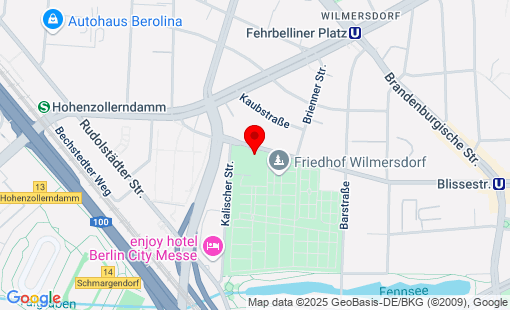Germany
Berlin-Wilmersdorf, Friedhof Wilmersdorf
Total Occupation: 1.991 fatalities
Total Occupation: 1.991 fatalities
Open all year round
Today's Wilmersdorf municipal cemetery was established in 1885/1886 as a municipal cemetery for the rural community of Deutsch-Wilmersdorf. After several expansions of the original 1 ha Alleequartier cemetery, the current size is 10.1 ha. The cemetery chapel, built in 1887 according to plans by Max Contag and Christian Havestadt, was destroyed during the Second World War and subsequently demolished. a crematorium was built between 1919 and 1923 and was used for cremations until 1990. the construction of several columbaria began in 1925; the garden courtyard in Moorish-Gothic style is particularly noteworthy. The cemetery is home to various impressive gravesites, such as the one for Rittmeister Freiherr Max Ildefonso von Dincklage, the Gieseler family grave, the Pfeffer grave complex and the Wislicenus-Finzelberg grave. The cemetery contains the gravesites of various personalities (see below). However, the graves of Peter Behrens, Robert Biberti, Alexander Calandrelli, Nikolaus Geiger and August von Parseval are unfortunately no longer there today. - Bruno Balz (6.10.1902-14.3.1988), author of more than 1,000 song and pop lyrics, including "Der Wind hat mir ein Lied erzählt", "Kenn denn Liebe Sünde sein", "Ich brech' die Herzen der stolzesten Frau'n", "Das kann doch einen Seemann nicht erschüttern", "Ich weiß, es wird einmal ein Wunder gescheh'n", "Wir wollen niemals auseinandergeh'n" and many others - Peter Behrens (14.4.1868-27.2.1940), architect, painter, designer and typographer, one of the founders of modern industrial design, designer of the "Antiqua" typeface and the lettering "DEM DEUTSCHEN VOLKE" on the Reichstag building - Robert Biberti (5.6.1902-2.11.1985), singer with the "Comedian Harmonists" - Curt Bois (5.4.1901-25.12.1991), theater and film actor - Alexander Calandrelli (9.5.1834-26.5.1903), sculptor (including "Auszug der Truppen und Erstürmung der Düppeler Schanzen" on the west side of the base of the Berlin Victory Column) - Nikolaus Geiger (6.12.1849-27.11.1897), painter and sculptor (including Barbarossa for the Kyffhäuser National Monument, high frieze "The Army" for the Soldiers' and Sailors' Monument in Indianapolis, USA) - Felix Klemperer (9.10.1866-2.4.1932), internist (brother of Victor and Georg Klemperer); the grave is no longer preserved - Ernst Niekisch (23.5.1889-23.5.1967), politician and political writer, representative of anti-democratic and anti-Western national Bolshevism - August von Parseval (5.2.1861-22.2.1942), designer of the airships named after him - Rudolf Platte (12.2.1904-18.12.1984), actor (honorary grave) - Willy Römer (31.12.1887-26.10.1979), press photographer and owner of an important picture agency at the time of the first German Republic - Heinrich Seeling (1.10.1852-15.2.1932), architect (not least of many theater buildings; honorary grave) - Wolfgang Völz (16.8.1930-2.5.1918), actor and voice actor The cemetery contains more than two thousand victims of the First and especially the Second World War in several burial plots, including three collective graves of 54 m².
